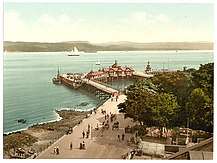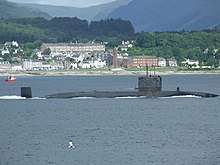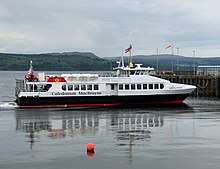Dunoon
Dunoon (/dʌˈnuːn/; Scottish Gaelic: Dùn Omhain) is the main town on the Cowal peninsula in the south of Argyll and Bute, Scotland. It is located on the western shore of the upper Firth of Clyde, to the south of the Holy Loch and to the north of Innellan.[2] As well as forming part of the council area of Argyll and Bute, Dunoon also has its own community council.[3]
Dunoon
| |
|---|---|
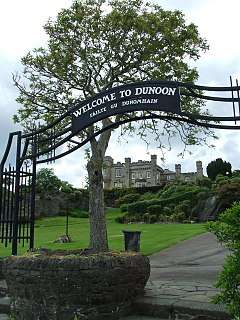 Castle House | |
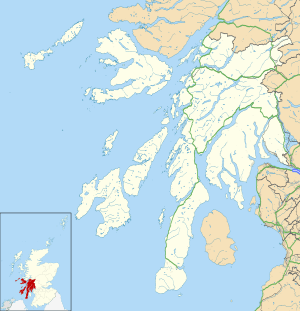 Dunoon Location within Argyll and Bute | |
| Population | 4,487 [1] (2013 est.) Dunoon only. Not including Kirn, Hunters Quay or Innellan. |
| OS grid reference | NS173769 |
| • Edinburgh | 67 mi (108 km) |
| • London | 364 mi (586 km) |
| Council area |
|
| Lieutenancy area |
|
| Country | Scotland |
| Sovereign state | United Kingdom |
| Post town | DUNOON |
| Postcode district | PA23 |
| Dialling code | 01369 |
| UK Parliament | |
| Scottish Parliament | |
The early history of Dunoon often revolves around two feuding clans: the Lamonts and the Campbells. Dunoon was a popular destination when travel by steamships was common around the Firth of Clyde; Glaswegians described this as going doon the watter.[4] This diminished, and many holidaymakers started to go elsewhere as roads and railways improved and the popularity of overseas travel increased.
In 1961, during the height of the Cold War, Dunoon became a garrison town to the United States Navy. In 1992, they closed their Holy Loch base in Sandbank, and neighbouring Dunoon suffered an economic downturn. Since the base's closure, the town and surrounding area are again turning to tourism, marketing to outdoor enthusiasts and wildlife lovers, as well as promoting festivals and competitions. The largest annual event held in the town is the Cowal Highland Gathering, which has been held since 1894.[5] The Royal National Mòd has been also been held in the town.[6]
Geography
Dunoon is on the west coast of the Firth of Clyde,[7] and on the east coast of the Cowal peninsula.
History

Dunoon Castle was built on a small, partly artificial, conical hill beside the Firth of Clyde in the 12th century, of which low walls remain.[8] It eventually became a royal castle with the Earls of Argyll (Campbells) as hereditary keepers, paying a nominal rent of a single red rose to the sovereign. Mary, Queen of Scots visited Dunoon Castle on 26 July 1563 and granted several charters during her visit.[9] In 1646 the Dunoon massacre of members of Clan Lamont by members of Clan Campbell took place. The castle was destroyed during Argyll's Rising, a rebellion in 1685 against James VII.[10]
Modern Dunoon owes its existence to steam power; as late as 1822 there were only three or four slated houses, the rest of the residences being traditional Highland cottages.[11] In the New Statistical Account, the MP James Ewing from Glasgow is named as beginning the expansion of the village when he built Castle House close to Dunoon Castle.[12] The growth of the village increased from that time, paralleling the engineering-led growth of the steamers.[13] Other infrastructural advances also helped like the construction of a 130-yard-long (120-metre) jetty in 1835.[14] From 1812 to the late 1960s, thousands of holiday-makers travelled doon the watter from Glasgow and industrial Lanarkshire to Dunoon and to numerous other town piers on the Firth of Clyde. Only one Clyde steamer, the Waverley, satisfies demand for this business today.
During the Second World War, as the main part of the Firth of Clyde defences, an anti-submarine boom was anchored to the shore in Dunoon.[15][16] A Palmerston Fort and camp at Ardhallow in the south of the town, provided one of the coastal defence gun emplacements that covered the anti-submarine boom and Firth of Clyde waters. There also was a gun emplacement on top of Castle Hill.
In 1961, as the Cold War intensified, the Holy Loch became internationally famous when the U.S. Navy submarine tender USS Proteus brought Polaris ballistic missiles, nuclear submarines to the Firth of Clyde at Sandbank. Campaign for Nuclear Disarmament protesters drew this to the public's attention.[17] Holy Loch was, for thirty years, the home port of US Navy Submarine Squadron 14 and Dunoon, therefore, became a garrison town.
In 1991, the Holy Loch base was deemed unnecessary following the demise of the Soviet Union and was subsequently withdrawn. The last submarine tender to be based there, the USS Simon Lake, left Holy Loch in March 1992, leading to a major and continuing downturn in the local economy.
In May 2012, Dunoon and Campbeltown were jointly named as the rural places in Scotland most vulnerable to a downturn in a report by the Scottish Agricultural College looking at 90 places.[18][19]
Culture and festivals
The Cowal Highland Gathering, established in 1894, attracts contestants and spectators from all over the world.[20] It is held annually over the final weekend in August at Dunoon Stadium.[21]
Cowal Open Studios, held over a fortnight in September, gives the opportunity to visit the studios of artists around Dunoon and Cowal.
Cowalfes, celebrates the outdoors activities like rambling around Dunoon for ten days in October.
Since the 1930s Dunoon has hosted the Royal National Mòd a number of times – 1930, 1950, 1968, 1994, 2000, 2006, 2012 and 2018.[22]
In 2013, the first Dunoon Film Festival was held over three days and opened with first public screening of Your Cheatin' Heart, a series made by the BBC that had last been shown on television in 1990.[23]
Tourist attractions
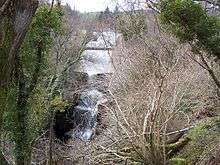
The Waverley paddle steamer berths at the breakwater when visiting Dunoon during its summer season.[24]
Local wildlife includes seals, otters, dolphins, basking sharks, roe deer, red deer, red squirrels, and many species of birds.[25]
The town and surrounding area are becoming recognised as a destination for outdoor pursuits, including walking, running, golfing, kayaking, sailing, fishing, climbing, triathlon and mountain biking.
Trails (walks, running and mountain biking) thread through the hills surrounding Dunoon. Corlarach Hill has waymarked routes for walkers, mountain biking and horse riders.[26][27] These trails are located next to the Bishop's Glen.
Puck's Glen is a popular short walk set in the hills close to Benmore Botanic Garden. (The arboretum at Benmore Botanic Garden, formerly a private garden for the Younger family,[28] is now open to the public. It comprises 60 hectares (150 acres) and features some of the tallest trees in Britain, including the avenue of Giant Redwoods (Sequoia), some of which are over 37 metres (120 ft) high.[29] One of Dunoon's listed buildings is the Grade 2 Victorian fernery, which was reopened in 2009 after an 18-month restoration.)[30] Part of the Royal Botanic Garden Edinburgh, the Garden is 7 miles (11 kilometres) north of the town, just before Loch Eck. A tumbling burn, criss-crossed by bridges, is enclosed by rocky walls heavily hung with mosses and overshadowed by dense trees. The walk has clear, waymarked paths. The glen is named after Puck, from A Midsummer Night's Dream.[31]
Morag's Fairy Glen is a short gorge walk, with trails alongside the Berry Burn, located on the hill behind the West Bay area of Dunoon.[32][33][34]
Bishops Glen trail follows the shore of the remaining one of three reservoirs in the glen, that used to supply fresh water to Dunoon. The reservoir is damming the Balgaidgh Burn (Balgie) and is now a fresh water rod fly fishing location.[35] Access to the hills behind Dunoon, including Corlarach Hill, is available from the Bishop's Glen Reservoir trails.[36]
The Castle House Museum opens during the summer season. It holds historical information and displays for Dunoon and the Cowal peninsula.[37]
The Category B listed Burgh Hall re-opened in June 2017, and is a fully accessible venue for exhibitions, performances and gatherings. Alongside a gallery and theatre, the venue offers creative workshop space, a garden and a café.[38][39][40]
Religion
There is evidence of an episcopal seat at Dunoon from the latter part of the 15th century. No remains of the Bishop's Palace now exist, with the site now occupied by the playground of Dunoon Primary School, between Hillfoot and Kirk Streets.[41]
Today, there are a number of churches in Dunoon, including:
Roman Catholic
- Our Lady and St Mun's Church[42]
Other churches
- Cowal Baptist Church[43]
- Dunoon Baptist Church Centre[44]
- Dunoon Free Church[45]
- Holy Trinity Episcopal Church
Kingdom Hall
- Kingdom Hall of Jehovah's Witnesses[46]
Landmarks
Dunoon's Victorian pier was built in 1835; it was extended to the current structure in 1895. The pier was shortened to allow the building of a breakwater in 2005, just to the south of the pier. As well as protecting the Victorian pier and its architecture from storm surges, a new link span was installed alongside the breakwater. This was to allow the berthing and loading of roll-on/roll-off ferries instead of the side-loading ferries that used to serve the pier. A tender to serve the new link-span between two interested parties, Caledonian MacBrayne and Western Ferries, came to nothing. Prior to June 2011, the pier was in daily use by Caledonian MacBrayne, who ran a regular foot passenger and car-ferry service to Gourock. However, after June 2011, a renewed tendering process produced a passenger-only ferry service (Argyll Ferries, owned by Caledonian MacBrayne) using the breakwater for berthing. On 1 September 2004, during the construction of the breakwater, the cargo vessel Jackie Moon (82 metres in length), ran aground on the breakwater, with six people on board. Since the breakwater became operational in June 2011, Argyll Ferries operate from this docking facility. The Waverley struck the breakwater on 26 June 2009, with some 700 people on board. The Victorian pier was partially refurbished by Argyll and Bute Council during 2015. Now containing meeting rooms, the pier is purely a tourist attraction.[47]
Mary Campbell (1763–1786) also known as "Highland Mary" and "Bonny Mary O' Argyll", was born at Auchamore in Dunoon. She started an affair with the bard Robert Burns. The Highland Mary statue was erected in 1896; it is prominently sited on Castle Hill, overlooking the breakwater in Dunoon.[48][49][50][51][52]
The war memorial of Dunoon is located in the Castle Gardens, overlooking the pier.[53]
Burgh Hall opened in 1874. It is a Scottish baronial-style building that housed the municipal offices and had a hall accommodating 500 people.[54]
A small group of rocks, known as the Gantocks, lie off the coast at Dunoon. The navigation beacon on the Gantocks in the Firth of Clyde is close to the coast at Dunoon. It was built in 1886.[55]
The Clan Lamont Memorial, also known as the Dunoon Massacre Memorial, is on Tom-A-Mhoid Road close to Castle Hill. It was dedicated in 1906 and commemorates the Dunoon massacre of 1646, when the Campbell Clan attacked the Lamont Clan, killing over 200 people.[56][57]
Transport
Dunoon is accessible by direct land and sea routes and indirectly by rail at Gourock. Dunoon lies towards the southern end of the A815 road. At its northernmost point, near Cairndow, this road joins the A83 and provides access to the town by road from Loch Lomond / Glasgow in the east, from the Inveraray / Oban in the north and from Campbeltown in the west. Two ferry operators provide services to Dunoon, Cowal peninsula from Gourock, Inverclyde. The Public Service route provided by the Scottish Government-owned Caledonian MacBrayne which is a foot passenger only service between Dunoon Breakwater and Gourock pier, giving easy access to the National Rail Network.[58] Local company Western Ferries (Clyde) LTD, carries motor vehicles and foot passengers between McInroy's Point, (A770, (Cloch Road)) and Hunters Quay near Dunoon.[59] At Gourock Pier, an Abellio ScotRail train service provides access to the National Rail network via the Inverclyde Line at Glasgow Central.[60]Public transport within Dunoon and the surrounding area is provided under government subsidy by bus and coach operator West Coast Motors.
West Coast Motors' route 486 provides a regular return journey from Dunoon town centre to Inveraray, where it connects with a Scottish Citylink service 926 and 976 onward to Campbeltown, Oban, Glasgow and points in-between.[61]
Community facilities
The Queen's Hall[62] is the town's major multi-function hall complex. It is situated opposite the head of the Victorian pier and built in 1958. It was officially opened by Queen Elizabeth II on 11 August 1958.[63] The building houses four function suites and a large main hall. The main hall has a stage with professional sound and lighting equipment, and attracted popular acts such as Pink Floyd,[64] Blur, the Saw Doctors, David Gray. Morrissey, the Red Hot Chilli Pipers, Primal Scream and comedians Kevin Bridges, Bill Bailey and Roy Chubby Brown. In late 2015 the Queen's Hall was closed to enable a major refurbishment. In December 2016 it was announced that the refurbishment would not commence until January 2017.[65] The Queens Hall reopened in August 2018.[66]
The town's sporting arena is Dunoon Stadium, which is located in the north of the town, near Dunoon Grammar School. When it hosted football matches, it had the largest capacity of any amateur ground in Scotland. It later became the focal point of the Cowal Highland Gathering. Motorcycle dirt track racing (or speedway) was staged at the stadium on 18 June 1932 as part of the annual Dunoon and Cowal Agricultural Show. A demonstration event had been staged in May 1932.
Riverside, swim and health centre, including an indoor pool (25m long) and associated facilities, located in the centre of Dunoon, next to the Firth of Clyde on Alexandra Parade. Facilities include a main pool, teaching pool, gym including a sauna and a water flume.[67]
Dunoon Library is situated in the rebuilt Queens Hall at the Castle Gardens.[68]
Education
Dunoon is served by three primary schools. Dunoon Primary School is on Hillfoot Street; this building was the original 1641 location of Dunoon Grammar School. St Muns Primary School[69] is on Pilot Street and Kirn Primary School is on Park Road.[70]
Dunoon Grammar School is located on Ardenslate Road in Kirn.
The University of the Highlands and Islands' Argyll College has a campus in Dunoon, located in the West Bay, near to the breakwater and Castle Hill.[71]
Sport and recreation
Fishing locations surround Dunoon, both fresh and sea water.[72]
Mountain biking trails are available.[73]
Dunoon Camanachd was established in 2015; the shinty team started competing in South Division 2, in 2016.
Cowal Golf Club is situated on the hillside above Kirn. It is an eighteen-hole, 6251-yard course with a par of seventy.[74][75]
The two bowling clubs in Dunoon are Dunoon Argyll Bowling Club, on Mary Street, and Bogleha' Bowling Club, on Argyll Street.
In 2006 and 2007, the town hosted a six-a-side swamp football tournament that attracted around 500 players and 1000 spectators.[76][77]
Cowal Rugby Club was formed in 1976. In 2008 it scored its first league victory in the Scottish Hydro Electric Western Regional League West Division 2.
Dunoon Amateurs F.C. was founded in 1975 and play football at Dunoon Stadium and Dunoon Grammar School.
The Dunoon Youth Football League (DYFL), founded in 1981, is a voluntary organisation that teaches football skills to all interested children with ages between 4 and 17. The DYFL have their own clubhouse and changing facilities at Dunoon Stadium. All coaches are parents who have received coaching certification through the Scottish Youth Football Association (SYFA), and the club has a PGA officer and coaches with Sports Injuries First Aid Certification. As of January 2015 the club had a membership of over 125 children.
Castle Tennis Club is situated in the town's Castle Garden. The club has two concrete and two all-weather courts, all lighted.
Every year in June the town hosts the Argyll Rally, a motorsport event that takes place in the forests around the local area. The rally counts as a round of the Scottish Rally Championship and brings competitors from all over United Kingdom.[78]
Notable people
Dunoon's most notable resident was Sir Harry Lauder (1870–1950), whose mansion, Laudervale, stood just south of Dunoon on Bullwood Road. After a fire, which burnt over half of it, it stood ruinous until around 1980, when it and the stable blocks were demolished. Much of the grounds were subsequently sold for housing development. The development there today preserves the Laudervale name.
- Virginia Bottomley, politician
- Robert Alexander Bryden, architect
- MT Carney, business woman
- Donald Caskie, minister and escape line operative in Vichy France
- Peter Dorschel, Cold War spy
- William Fraser, lived in the town and designed Dunoon Pavilion
- Stewart Houston, footballer
- Neil MacFarlane, footballer
- Sylvester McCoy, actor
- Alexander Robertson, boatbuilder
- George Robertson, politician
- John Smith, politician
- Brian Wilson, politician
- Tom Wisniewski, musician
Media
Dunoon's local weekly newspaper is the Dunoon Observer and Argyllshire Standard, which was founded on 25 March 1871 in Sandbank by William Inglis, Sr.,[79][80] who was editor and proprietor.
On 1 December 2009, Dunoon Community Radio was launched.[81] Dunoon Community Radio, often called "DCR" by its presenters, has a variety of programming to meet the needs of people living in around Dunoon. Broadcasting on 97.4 FM from the Dunoon Observer building, Dunoon Community Radio is an independent social business entirely staffed by volunteers.
The town was the inspiration behind Damon Albarn's song "The Selfish Giant" on his 2014 solo album Everyday Robots. The song makes particular references to the town ("Walking down Argyll Street when the evening colours call").[82]
Climate
As with the rest of the British Isles, Dunoon has a maritime climate with cool summers and mild winters. It is an exceptionally wet part of the country, particularly so for a place near sea-level, with annual average rainfall totals nearing 2,400 mm (94 in).
Recorded temperature extremes since 1960 range from 29.6 °C (85.3 °F) during July 1983[83] to as low as −13.9 °C (7.0 °F) during January 1982.[84]
| Climate data for Benmore Botanic Gardens 12m asl, 1971–2000, extremes 1960– (Weather station 7 mi (11 km) to the North of Dunoon) | |||||||||||||
|---|---|---|---|---|---|---|---|---|---|---|---|---|---|
| Month | Jan | Feb | Mar | Apr | May | Jun | Jul | Aug | Sep | Oct | Nov | Dec | Year |
| Record high °C (°F) | 14.4 (57.9) |
14.5 (58.1) |
17.2 (63.0) |
23.6 (74.5) |
27.0 (80.6) |
28.9 (84.0) |
29.6 (85.3) |
29.0 (84.2) |
25.1 (77.2) |
21.7 (71.1) |
16.5 (61.7) |
14.2 (57.6) |
29.6 (85.3) |
| Average high °C (°F) | 6.5 (43.7) |
6.8 (44.2) |
8.6 (47.5) |
11.4 (52.5) |
14.9 (58.8) |
16.8 (62.2) |
18.4 (65.1) |
18.0 (64.4) |
15.3 (59.5) |
12.2 (54.0) |
8.9 (48.0) |
7.2 (45.0) |
12.1 (53.8) |
| Average low °C (°F) | 1.0 (33.8) |
1.3 (34.3) |
2.2 (36.0) |
3.4 (38.1) |
5.8 (42.4) |
8.5 (47.3) |
10.7 (51.3) |
10.4 (50.7) |
8.6 (47.5) |
6.1 (43.0) |
2.9 (37.2) |
1.7 (35.1) |
5.2 (41.4) |
| Record low °C (°F) | −13.9 (7.0) |
−11.1 (12.0) |
−11.1 (12.0) |
−4.4 (24.1) |
−2.5 (27.5) |
−0.6 (30.9) |
2.2 (36.0) |
2.6 (36.7) |
−0.9 (30.4) |
−4.1 (24.6) |
−6.8 (19.8) |
−11.5 (11.3) |
−13.9 (7.0) |
| Average precipitation mm (inches) | 298.76 (11.76) |
214.43 (8.44) |
233.63 (9.20) |
119.48 (4.70) |
105.12 (4.14) |
108.54 (4.27) |
127.66 (5.03) |
160.85 (6.33) |
220.49 (8.68) |
257.6 (10.14) |
257.82 (10.15) |
282.98 (11.14) |
2,387.36 (93.98) |
| Source: Royal Dutch Meteorological Institute/KNMI[85] | |||||||||||||
Gallery
- Dunoon
.jpg) Dunoon Grammar School Hostel
Dunoon Grammar School Hostel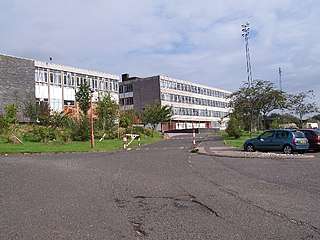 Dunoon Grammar School in 2005 (since demolished and rebuilt)
Dunoon Grammar School in 2005 (since demolished and rebuilt).jpg) Pipe band at the Cowal Highland Gathering
Pipe band at the Cowal Highland Gathering Dunoon from above the Firth of Clyde
Dunoon from above the Firth of Clyde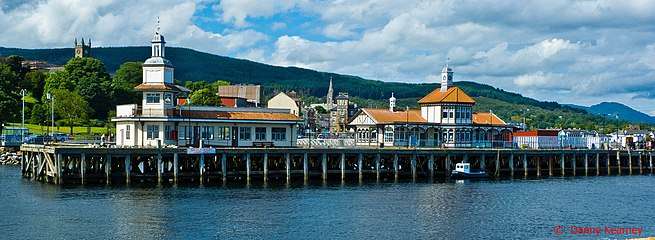 Dunoon Pier
Dunoon Pier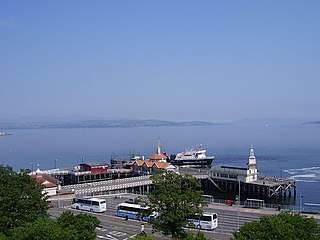 Another view of Dunoon Pier
Another view of Dunoon Pier
 Dunoon Castle Gardens and war memorial
Dunoon Castle Gardens and war memorial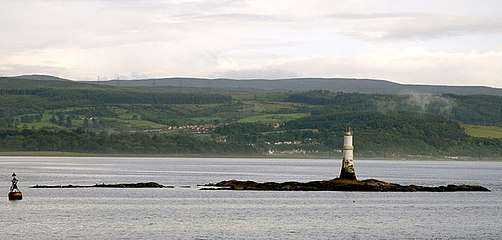 The Gantocks from Dunoon
The Gantocks from Dunoon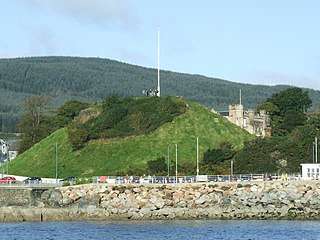 Castle Hill
Castle Hill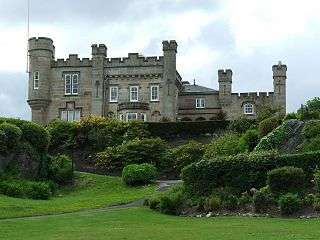 Castle House Museum
Castle House Museum
References
- "Population estimates 2013". Statistics Scotland.
- "OS 25-inch map 1892–1949, with Bing opacity slider". National Library of Scotland. Ordnance Survey. Retrieved 12 October 2017.
- "Dunoon Community Council | Home & Latest News". www.community-council.org.uk.
- "Scottish phrase of the week: Doon the watter". www.scotsman.com.
- www.samteq.co.uk, SAMTEQ. "Cowal Highland Gathering – World's Biggest Highland Games". Retrieved 21 February 2017.
- info@reefnet.co.uk. "An Comunn Gàidhealach – Royal National Mod : Mod News". Retrieved 21 February 2017.
- info@undiscoveredscotland.co.uk, Undiscovered Scotland. "Dunoon Feature Page on Undiscovered Scotland".
- "Dunoon Castle". Canmore. Retrieved 11 December 2016.
- "Gazetteer for Scotland: Dunoon". Scottish-places.info. Retrieved 14 December 2016.
- Kennedy, A. (2016). "Rebellion, Government and the Scottish Response to Argyll's Rising of 1685" (PDF). Journal of Scottish Historical Studies. 36: 40–59. doi:10.3366/jshs.2016.0167.
- Macdonald, Hugh (1878). Days at the coast : a series of sketches descriptive of the Firth of Clyde, its watering places, its scenery, and its associations. Glasgow: Dunn. p. 346. Retrieved 11 July 2018.
- Mackay, M (1845). The new statistical account of Scotland (Vol 7 ed.). Edinburgh and London: W. Blackwood and Sons. p. 607. Retrieved 11 July 2018.
- "OS 6-inch map 1843–1882, with Bing opacity slider". National Library of Scotland. Ordnance Survey. Retrieved 12 October 2017.
- Williamson, James (1904). The Clyde passenger steamers : its rise and progress during the nineteenth century : from the 'Comet' of 1812 to the 'King Edward' of 1901. Glasgow: J. Maclehose. p. 78. Retrieved 11 July 2018.
- "Clyde Defences, Cloch Point To Dunoon Anti-submarine Boom". Canmore. 3 July 2013. Retrieved 15 February 2017.
- "Bute during World War II". www.bute-at-war.org.
- "Anti-Polaris Protest at Dunoon. Angry Kerbside Exchanges". The Glasgow Herald. 15 May 1961. p. 8. Retrieved 11 December 2016.
- "'Vulnerable' Scottish rural towns listed". BBC News. 28 May 2012. Retrieved 11 December 2016.
- Cowling, Emma (27 May 2012). "Revealed: our rural towns on the brink". Scotsland on Sunday. Retrieved 11 December 2016.
- "COWAL HIGHLAND GATHERING (1974)". Moving Image Archive. National Library of Scotland. Retrieved 11 July 2018.
- "Cowal Highland Gathering – World's Biggest Highland Games". Cowalgathering.com. Retrieved 22 November 2016.
- List of Mod's places for each year on Sabhal Mòr Ostaig website
- "Your Cheatin' Heart to open first Dunoon Film Festival". BBC News. 10 May 2013.
- Taylor, Marianne (9 May 2015). "The Waverley: Paddling doon the watter for 40 years". The Herald. Retrieved 11 December 2016.
- "Where to Find wildlife – visitcowal". Retrieved 21 February 2017.
- "Explore woods: Corlarach Hill". The Woodland Trust. Archived from the original on 24 November 2016. Retrieved 11 December 2016.
- "Corlarach". Forestry Commission Scotland. Retrieved 11 December 2016.
- "Younger Family at Benmore".
- "Royal Botanic Garden Edinburgh – Benmore Botanic Garden". Rbge.org.uk. 8 March 2016. Retrieved 22 November 2016.
- "Gardens: Benmore Botanic Garden, Dunoon, Argyll". The Scotsman. 17 October 2009. Retrieved 12 January 2017.
- "Puck's Glen". Government of the United Kingdom. Retrieved 22 November 2016.
- "Dunoon Visitor Guide - Accommodation, Things To Do & More". Visit Scotland.
- "Morag's Fairy Glen, West Bay,Dunoon". 28 March 2015.
- https://canmore.org.uk/site/348292/morags-fairy-glen
- "..Dunoon Reservoir". 19 March 2015.
- "Dunoon Visitor Guide - Accommodation, Things To Do & More". www.visitscotland.com.
- "Castle House Museum Dunoon. History, culture, geneaology services, clans and exhibitions". Castlehousemuseum.org.uk. Retrieved 22 November 2016.
- "Hall reopens as contemporary arts centre". BBC News. 19 June 2017. Retrieved 21 May 2018.
- "Burgh Hall". Theatres Database. The Theatres Trust. Retrieved 20 February 2017.
- "Argyll Street, Burgh Hall Building". Historic Environment Scotland. Retrieved 20 February 2017.
- DUNOON CONSERVATION AREA APPRAISAL and CONSERVATION STRATEGY, 2017 - Argyll & Bute Council
- "Our Lady and St Mun's Church Dunoon". stmuns.
- "Cowal Baptist Church, Dunoon". 24 September 2017.
- "Dunoon Baptist Church – Working, Worshipping and Witnessing for God in the community". dunoonbaptistchurch.org.
- "Church". Free Church of Scotland.
- "Kingdom Hall Of Jehovah'S Witnesses - Church - Dunoon Argyll & Bute UK". dunoon.inuklocal.co.uk.
- "Dunoon". Piers.org.uk. National Piers Society. Retrieved 12 December 2016.
- "Robert Burns and Highland Mary". Portal to the Past. Retrieved 14 December 2016.
- Caw, James Lewis. "Stevenson David Watson". Wikisource.
- "Statue Of 'Highland Mary'". Portal.historicenvironment.scot. Retrieved 11 January 2017.
- "Robert Burns Country: The Burns Encyclopedia: Highland Harry". Robertburns.org. Retrieved 22 November 2016.
- Webmaster, Tim Gardner -. "David Watson Stevenson (1842–1904), sculptor, a biography".
- "Dunoon Cenotaph WW1 and WW2 - War Memorials Online". www.warmemorialsonline.org.uk.
- "Dunoon's culture and events hub". Dunoon Burgh Hall. Retrieved 20 February 2017.
- "Secret Scotland - The Gantocks". Secret Scotland.
- Historic Environment Scotland. "Dunoon, Tom A Mhoid Road, Clan Lamont Memorial (183507)". Canmore. Retrieved 21 February 2017.
- "Clan Lamont Memorial, Dunoon". Commemorations Project. The Scottish Military Research Group. Retrieved 21 February 2017. Includes several photographs
- "Gourock to Dunoon Service | CalMac Ferries". Calmac Ferries.
- "Western Ferries (Clyde) Ltd". Western Ferries.
- "Train to and from Gourock | ScotRail". Scotrail.
- "486 - Dunoon to Inveraray". West Coast Motors.
- "The Queens Hall – Dunoon | Argyll and Bute Council". Argyll-bute.gov.uk. Retrieved 22 November 2016.
- "Dunoon Queens Hall Meet the Buyer – Supplier Development Programme". Sdpscotland.co.uk. Retrieved 11 January 2017.
- "Pink Floyd's stormy trip to Dark Side of Dunoon".
- Gordon (16 December 2016). "Queens Hall – Work to begin". Dunoon Observer. Retrieved 17 December 2016.
- "Dunoon Queen's Hall handover complete". Argyll and Bute Council. 27 July 2018. Retrieved 15 January 2019.
- "Riverside Leisure Centre".
- "Dunoon Library".
- Council, Argyll and Bute (3 November 2010). "St Muns Primary School".
- Council, Argyll and Bute (31 January 2018). "Kirn Primary School". Kirm Primary School.
- "Argyll College UHI". University of the Highlands and Islands. Retrieved 7 December 2016.
- "Cowal Feature Page on Undiscovered Scotland". Undiscovered Scotland. Retrieved 22 November 2016.
- "Dunoon - the best Scottish trail centre you've never heard of". MBR.
- www.samteq.co.uk, SAMTEQ. "Cowal Golf Club – Stunning 18 Hole in Cowal, Argyll".
- "Cowal Golf Club, Dunoon – Golf". Visit Scotland.
- "Dunoon swamped by football fans". BBC News. 1 July 2006. Retrieved 11 December 2016.
- "'Swamp soccer' teams play dirty". BBC News. 16 July 2007. Retrieved 11 December 2016.
- "Argyll Rally Homepage". Argyll Rally. Retrieved 9 February 2019.
- "History of the Dunoon Observer". Dunoon-observer.com. Retrieved 9 April 2012.
- "Evening Times – Google News Archive Search".
- "Dunoon, Cowal, Argyll, Scotland radio station, English and Gaelic programmes". Dunoon Community Radio. Retrieved 14 January 2012.
- "Damon Albarn on how Dunoon inspired debut album". www.scotsman.com. Retrieved 30 May 2019.
- "1983 Maximum". KNMI.
- "1982 Minimum". KNMI.
- "Benmore averages". KNMI. Retrieved 3 November 2011.
External links
- Map sources for Dunoon
| Wikimedia Commons has media related to Dunoon. |
| Wikisource has the text of the 1911 Encyclopædia Britannica article Dunoon. |
| Wikivoyage has a travel guide for Dunoon. |
